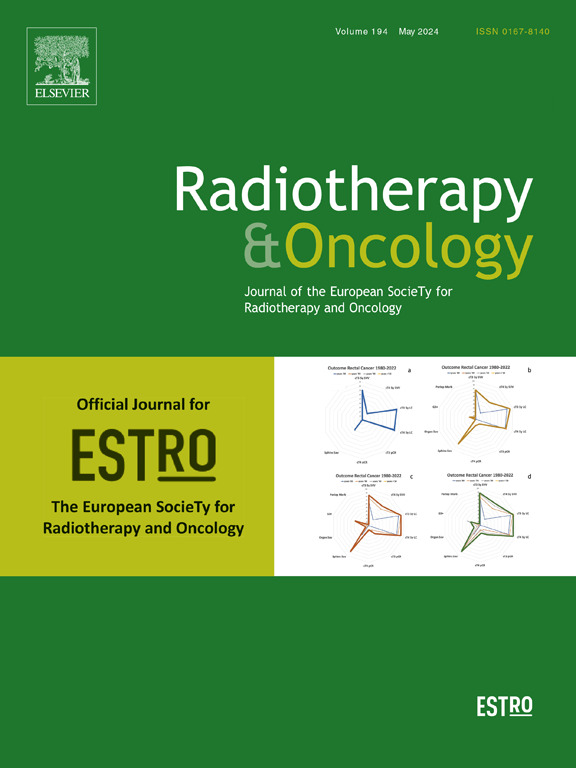利用高适形图像引导放疗对高危神经母细胞瘤进行局部控制,缩小边缘并对残留病灶进行增量治疗。
IF 4.9
1区 医学
Q1 ONCOLOGY
引用次数: 0
摘要
简介针对高危神经母细胞瘤(HR-NBL)的放疗方案在国际研究中各不相同。本研究的目的是评估全国HR-NBL队列中采用高适形图像引导放疗(IGRT)治疗的局部区域控制情况,采用缩小边缘的方法,并对残留病灶进行增量治疗:2015年至2022年间接受放疗作为一线HR-NBL治疗一部分的患者均符合条件。为了获得临床、内部和计划目标体积,在编辑的肿瘤总体积基础上分别增加了+0.5厘米、基于4DCT和+0.3/0.5厘米的边缘。处方剂量为21.6/1.8 Gy,放疗计划时残留病灶体积≥1 cm3的,处方剂量为14.4/1.8 Gy。调强弧治疗与基于锥形束 CT 的每日患者位置在线验证相结合。比较了放疗前残留病灶3 cm3与≥1 cm3(核素和核磁共振[弥散加权成像]扫描显示有/无局部活动)、诊断年龄、MYCN状态、[131I]mIBG治疗、诱导化疗反应、放疗开始时间间隔和转移部位照射的局部失败率(LRF):77例患者中,34例有残留病灶(中位体积:10.0立方厘米,IQR 4.8-29.9),17例核磁共振扫描和10例磁共振扫描显示有活动性。5年LRF率为7.8%(95%置信区间为1.8-13.8),残留病灶3 cm3与≥1 cm3之间无显著差异(分别为6.4%与14.3%,P = 0.27),其他变量也无显著差异。所有6个LRF(2个孤立的,4个合并的)都发生了 结论:在HR-NBL中,IGRT的边缘缩小,残留病灶≥1 cm3时的提升剂量显示了极佳的局部控制效果,与现代文献不相上下。本文章由计算机程序翻译,如有差异,请以英文原文为准。
Locoregional control in high-risk neuroblastoma using highly-conformal image-guided radiotherapy, with reduced margins and a boost dose for residual lesions
Introduction
Radiotherapy protocols for high-risk neuroblastoma (HR-NBL) vary across international studies. The purpose of this study was to evaluate the locoregional control in a national HR-NBL cohort treated with highly-conformal image-guided radiotherapy (IGRT), using reduced margins, and a boost dose for residual lesions.
Materials and methods
Patients treated with radiotherapy as part of first-line HR-NBL treatment between 2015 and 2022 were eligible. To obtain clinical, internal, and planning target volumes, +0.5 cm, 4DCT-based, and + 0.3/0.5 cm margins, respectively, were added to the edited gross tumour volumes. Prescription dose was 21.6/1.8 Gy, followed by 14.4/1.8 Gy for any residual lesions measuring ≥ 1 cm3 at the time of radiotherapy planning. Intensity-modulated arc therapy was combined with daily cone beam CT-based online patient position verification. Locoregional failure (LRF) rates were compared for the presence of residual lesions < 1 cm3 vs. ≥ 1 cm3 (with/without locoregional activity on nuclear- and MRI[diffusion-weighted imaging]-scans) pre-radiotherapy, age at diagnosis, MYCN-status, [131I]mIBG therapy, response to induction chemotherapy, interval to radiotherapy onset, and metastatic site irradiation.
Results
Among the 77 included patients, 34 had residual lesions (median volume: 10.0 cm3, IQR 4.8–29.9) with activity visible on 17 nuclear- and 10 MRI-scans. Five-year LRF rate was 7.8 % (95 % confidence interval 1.8–13.8), and not significantly different between those with residual lesions < 1 cm3 vs. ≥ 1 cm3 (6.4 % vs. 14.3 %, respectively, p = 0.27), or any of the other variables. All 6 LRFs (2 isolated, 4 combined) occurred < 1.5 years post-radiotherapy.
Conclusion
In HR-NBL, IGRT with reduced margins and a boost dose for residual lesions ≥ 1 cm3 demonstrated excellent locoregional control, comparable to modern literature.
求助全文
通过发布文献求助,成功后即可免费获取论文全文。
去求助
来源期刊

Radiotherapy and Oncology
医学-核医学
CiteScore
10.30
自引率
10.50%
发文量
2445
审稿时长
45 days
期刊介绍:
Radiotherapy and Oncology publishes papers describing original research as well as review articles. It covers areas of interest relating to radiation oncology. This includes: clinical radiotherapy, combined modality treatment, translational studies, epidemiological outcomes, imaging, dosimetry, and radiation therapy planning, experimental work in radiobiology, chemobiology, hyperthermia and tumour biology, as well as data science in radiation oncology and physics aspects relevant to oncology.Papers on more general aspects of interest to the radiation oncologist including chemotherapy, surgery and immunology are also published.
 求助内容:
求助内容: 应助结果提醒方式:
应助结果提醒方式:


